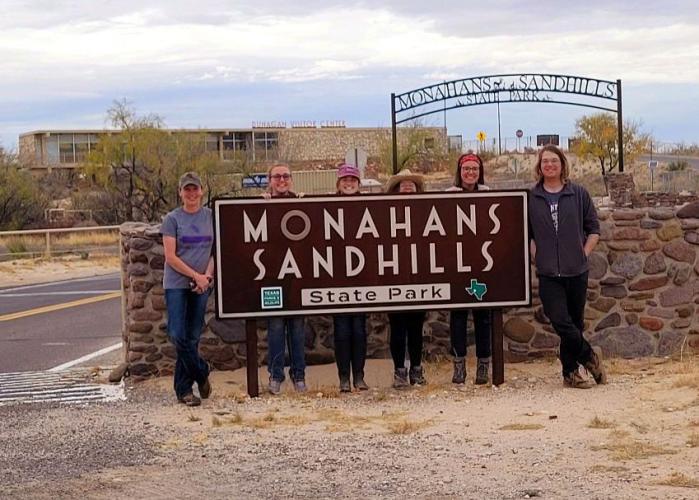NACOGDOCHES, Texas — Each year, more than 8 million people visit the 90 state parks, historic sites and natural areas managed by the Texas Parks and Wildlife Department. In order to continue to meet the needs of visitors and offer relevant programming that reaches all Texans, the agency seeks to better understand exactly who these guests are and what motivates them to visit. Three Stephen F. Austin State University graduate students are crisscrossing the state to find out.
“We are collecting information regarding visitor use in roughly two-thirds of the parks throughout the state,” said Mark Risinger, Master of Science in resource communications student. “This includes demographics, frequency of use and activities the visitors pursued during their stay.”
In December, Rachel Bjerkaas, also a resource communications graduate student, led a group of undergraduate research assistants to West Texas where they conducted surveys at Franklin Mountains, Davis Mountains, Balmorhea and Monahans Sandhills state parks. While some of the survey data, such as visitor count and documented recreational activities, is collected without directly interacting with park patrons, further information regarding park use and visitor perceptions is gleaned through direct conversations.
“Speaking with visitors is one of my favorite parts of this project,” Bjerkaas said. “I love listening to them and understanding what some of their most memorable experiences are.”
Bjerkaas, who earned a Bachelor of Science in environmental science from SFA, said this is one of the very reasons she chose to pursue a graduate degree.
“I wanted the opportunity to help others understand the importance of nature and environmental issues,” Bjerkaas said. “Pursuing a graduate degree in resource communications allows me to spend my time working with people in the beautiful outdoor places around us.”
As most Texans can attest, seasonality greatly affects which parks are visited and the activities guests enjoy. For example, during the summer, Texas state park patrons are often advised to avoid hiking during certain hours due to the threat of heat exhaustion. Conversely, many visitors flock to Texas to escape harsh winters.
“South Texas parks will see a number of snowbirds that visit during the winter,” said Cam Rojas, resource communications graduate student. “In order to quantify the seasonality change of parks, we’ll survey 30 select parks over summer, fall and spring.”
Following these in-park surveys, a second, more comprehensive online survey will be distributed to individuals present on the Texas State Parks’ email list.
While the subsequent results of these surveys are invaluable for the Texas Parks and Wildlife Department, Dr. Pat Stephens Williams, SFA professor of human dimensions of natural resources and project advisor, feels that the student growth taking place is the true asset.
“As we have progressed, we have recognized the individual strengths of each graduate student as they coordinate and lead the teams in data collection,” Stephens Williams said. “Some of the undergraduate students have absolutely blossomed in the field, and it has shown us how we can help improve and guide students in the future.”
In addition to supporting student growth, Stephens Williams notes that the project illustrates the importance of interdisciplinary collaboration. Dr. Ray Darville, chair of SFA’s Department of Anthropology, Geography and Sociology, serves as co-principal investigator for this and other research projects within the Arthur Temple College of Forestry and Agriculture.
This undertaking precedes the 100th anniversary of the founding of the Texas Parks and Wildlife Department, and it reflects the agencies dedication to serving all Texans.
“We’re always trying to create a more inclusive and welcoming environment, so having a strong understanding of our visitors, their backgrounds and their needs helps turn us into a stronger organization with better programming,” said David Kurtenbach, Texas Parks and Wildlife Department program director for business management. “We say it all the time — Texas State Parks are for everyone, and we want to create the type of environment where everyone feels that parks are a part of their life.”
 Axe ’Em, Jacks!
Axe ’Em, Jacks!
